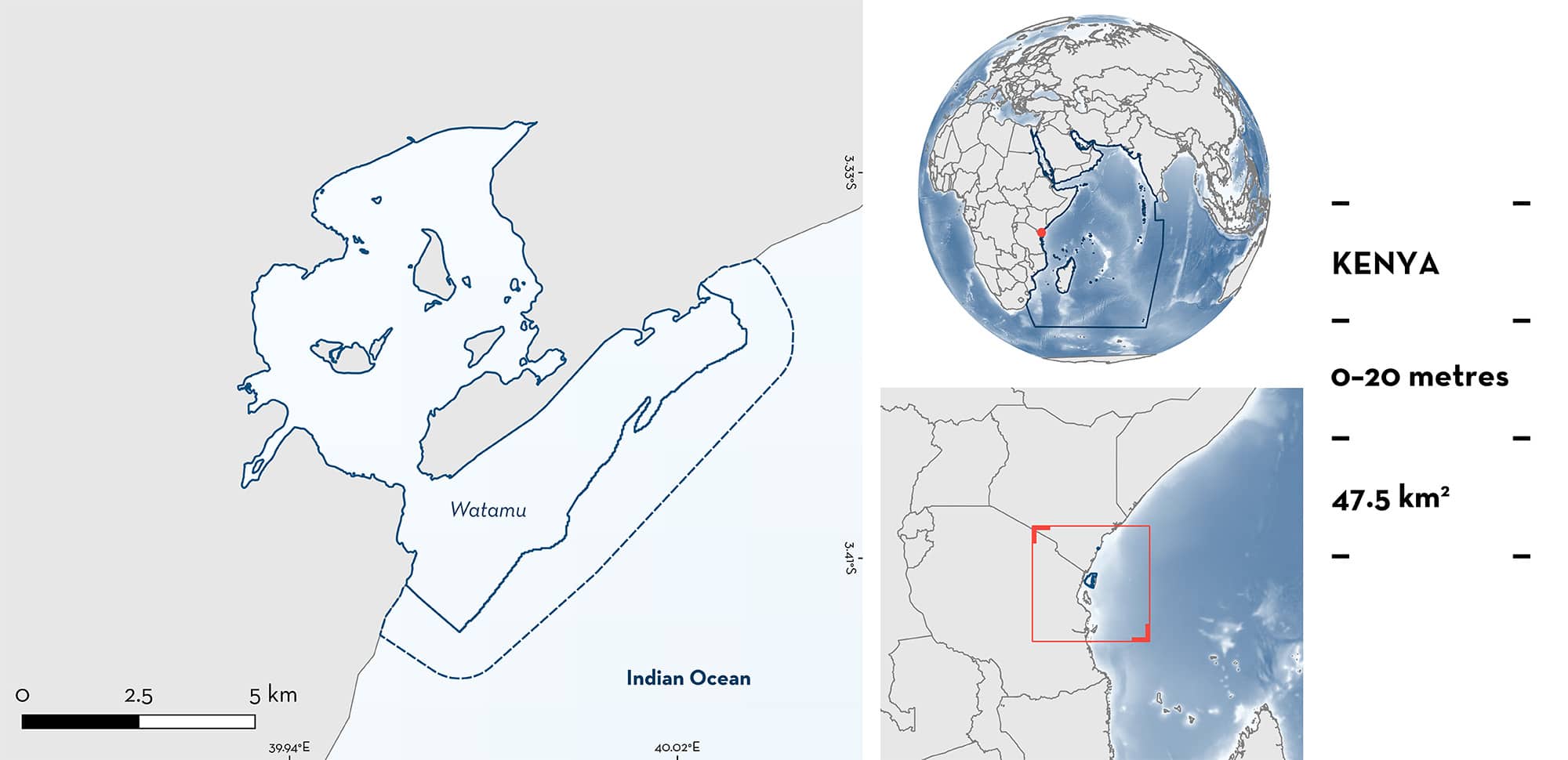ISRA FACTSHEETS
ISRA FACTSHEETS
WESTERN INDIAN OCEAN REGION
Watamu
Summary
Watamu is located on the north coast of Kenya. It is characterised by the presence of seagrasses, mangroves, fringing reefs, and muddy sand flats. The area overlaps with two Marine Protected Areas, one Ecologically or Biologically Significant Marine Area, and one Key Biodiversity Area. Whitin the area there are: threatened species (e.g., Whitetip Reef Shark Triaenodon obesus); reproductive areas (Blacktip Reef Shark Carcharhinus melanopterus); and resting areas (Whitetip Reef Shark).
Download factsheet
Watamu
DESCRIPTION OF HABITAT
Watamu is located on the north coast of Kenya, in Kilifi County. It is characterised by the presence of seagrass beds, mangroves, and fringing reefs forming several lagoons and stretching along the entire coastline (Cowburn et al. 2013). The northern part is a muddy high-nutrient bay with a sudden drop-off. The area contains a creek, Mida Creek, an expanse of tidal water covering an area of 32 km2 and opening to the sea through a channel 500 m wide. The creek is composed of muddy sand flats and deep-water channels fringed with mangroves (Cowburn et al. 2018).
Watamu overlaps with Watamu Area Ecologically or Biologically Significant Marine Area (EBSA) (CBD 2023) and with Mida Creek, Whale Island and the Malindi-Watamu coast Key Biodiversity Area (KBA) (KBA 2023). In addition, the area includes the Watamu/Malindi Marine Parks and Reserve which is divided into two marine parks: Malindi in the north, and Watamu in the south.
This Important Shark and Ray Area is benthopelagic and is delineated from inshore and surface waters (0 m) to 20 m based on the bathymetry of the area.
CRITERION A
VULNERABILITY
Two Qualifying Species considered threatened with extinction according to the IUCN Red List of Threatened SpeciesTM regularly occur in the area. These are the Vulnerable Blacktip Reef Shark (Simpfendorfer et al. 2020a) and Whitetip Reef Shark (Simpfendorfer et al. 2020b).
CRITERION C
SUB-CRITERION C1 – REPRODUCTIVE AREAS
Watamu is an important reproductive area for one shark species.
Blacktip Reef Sharks are one of the most abundant shark species in the area (Cowburn et al. 2018; Hindle et al. 2022). Neonates, young-of-the-year, and juvenile Blacktip Reef Sharks are regularly observed year-round in shallow sandy habitats, mangroves, and seagrass areas. Underwater visual census (UVC) surveys conducted from 2016 to 2023, several times a month, recorded 3–15 individuals per survey, of estimated sizes ranging 30–200 cm total length (TL), particularly from August to November and February through April (A Rocha Kenya unpubl. data 2023). Animals measuring less than 70 cm TL (n = 123) were often reported as swimming in the tide line or very shallow waters. Reported size-at-birth for this species is 30–52 cm TL (Ebert et al. 2021), confirming that some of these individuals were neonates/young-of-the-year.
Based on shore surveys from 2020–August 2023, 257 Blacktip Sharks were observed in shallow waters (A Rocha Kenya unpubl. data 2023). Estimated sizes for 20 of these individuals were < 40 cm TL and < 67 cm TL for 50 of individuals, confirming the regular presence of these early life stages in the area. Larger females were seen from August–November in rock pools, seagrass beds, and sandy patches in the southern part of the area during low tides (Hindle et a. 2022). In addition, footage of a female that appears to have recently given birth was recorded in early November.
Neonate and young-of-the-year Blacktip Reef Sharks commonly use sandflats areas and mangrove areas as nurseries (Oh et al. 2017) with Watamu providing suitable habitats for these life-stages.
CRITERION C
SUB-CRITERION C3 – RESTING AREAS
Watamu is an important resting area for one shark species.
Based on UVC surveys conducted between 2020–2023, groups of 2–5 Whitetip Reef Sharks are regularly seen in the area resting between rockpools, coral reefs, seagrass, and sandy patches in the entrance of the lagoons and in outer reefs at depths of 10 m. Whitetip Reef Sharks are commonly observed between August–December (A Rocha Kenya unpubl. data. 2023).
Download factsheet
SUBMIT A REQUEST
ISRA SPATIAL LAYER REQUEST
To make a request to download the ISRA Layer in either a GIS compatible Shapefile (.shp) or Google Earth compatible Keyhole Markup Language Zipped file (.kmz) please complete the following form. We will review your request and send the download details to you. We will endeavor to send you the requested files as soon as we can. However, please note that this is not an automated process, and before requests are responded to, they undergo internal review and authorization. As such, requests normally take 5–10 working days to process.
Should you have questions about the data or process, please do not hesitate to contact us.


